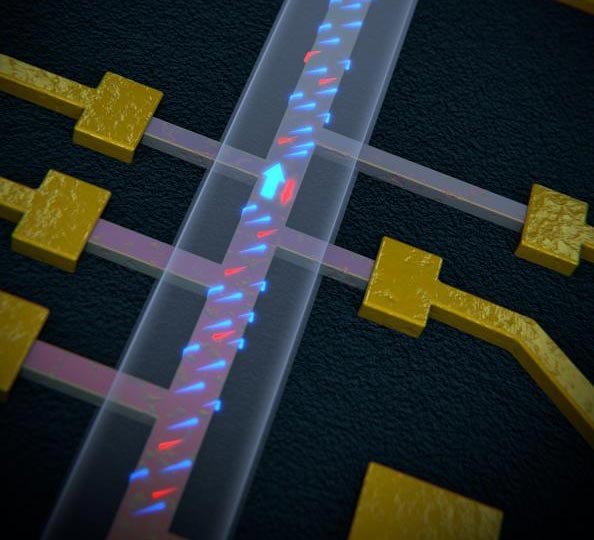Quantum one-way street in topological insulator nanowires

Applying a magnetic field causes current to flow more easily in one direction along the nanowire than in the opposite one.
Credit: University of Basel, Department of Physics
Very thin wires made of a topological insulator could enable highly stable qubits, the building blocks of future quantum computers. Scientists see a new result in topological insulator devices as an important step towards realizing the technology’s potential.
An international group of scientists have demonstrated that wires more than 100 times thinner than a human hair can act like a quantum one-way street for electrons when made of a peculiar material known as a topological insulator.
The discovery opens the pathway for new technological applications of devices made from topological insulators and demonstrates a significant step on the road to achieving so-called topological qubits, which it has been predicted can robustly encode information for a quantum computer.
To achieve this result, the groups of Professor Dr. Jelena Klinovaja and Professor Dr. Daniel Loss at the University of Basel closely collaborated with experimental physicists at the University of Cologne in the group of Professor Dr. Yoichi Ando. Their study has now been published in Nature Nanotechnology.
Topological insulators are materials in which a combination of quantum mechanics and the mathematical concept of topology produce conductive surfaces and insulating interiors. Topological insulators are highly promising candidates for future technologies and as potential platforms for quantum computing.
The researchers were able to show that, under the right circumstances, electric currents can flow more easily in one direction compared to the other, a process known as rectification. Rectification offers a wide range of applications and forms the basis of most wireless technologies.
Rectifiers found in smartphones, for example, are now made of semiconductor diodes. However, the current rectification effect discovered in topological insulator nanowires arises as a result of quantum mechanics and is extremely controllable.
Usually, quantum rectification effects arise as a result of something known as spin-orbit coupling, which is a mix of quantum mechanics and Einstein’s theory of relativity. As one might expect, that strange mix normally results in tiny rectification effects.
“What’s great about the topological insulator nanowires is that we can artificially produce essentially the same physics but with a much larger magnitude,” says Dr. Henry Legg, Georg H. Endress postdoctoral fellow at the University of Basel and first author of the paper. “This leads to a rectification effect that’s really huge compared to other materials. It’s also one of the aspects that makes topological insulators so exciting for applications in quantum computing.”
Beyond Ohm’s law
Ohm’s law states that the current flowing through a device is governed by the voltage drop across it and a quantity known as resistance. However, when quantum mechanics is at play, Ohm’s law sometimes needs to be corrected.
In particular, if a material or a device does not look the same when all its spatial properties are mirrored – so-called broken spatial inversion symmetry – applying a magnetic field means the quantum version of Ohm’s law allows current to flow more easily in one direction compared to the other. The size of the current rectification is determined by the difference between the resistances in each direction.
The high degree of control possible in topological insulator devices allowed the team of researchers to achieve a truly gigantic rectification effect compared to what had previously been observed.
Robust quantum information
Quantum computers promise unprecedented computing power, but are very susceptible to the influence of the external environment. One proposed solution to the fragility of quantum units of information – so-called qubits – are topological qubits, which it is predicted will be far more stable against the influences of the external environment. This protection also arises as a result of the mathematics of topology that underlies the properties of topological insulators.
Topological insulators have long been considered as good candidates to be the basis for topological quantum computers. However, good control over topological insulator devices is essential to be able to produce topological qubits.
“Our study not only discovered a unique and very large quantum effect, but it also shows that we have an excellent degree of understanding what is happening in these systems. It seems like all the key properties of topological insulators are there to move forward on the path to making topological qubits,” comments Professor Dr. Jelena Klinovaja from the University of Basel.
Wissenschaftliche Ansprechpartner:
Dr. Henry F. Legg, University of Basel, Department of Physics, email: henry.legg@unibas.ch, phone: +41 78 420 69 68
Originalpublikation:
Henry F. Legg et al.
Giant magnetochiral anisotropy from quantum confined surface states of topological insulator nanowires
Nature Nanotechnology (2022); doi: 10.1038/s41565-022-01124-1
https://www.doi.org/10.1038/s41565-022-01124-1
Media Contact
All latest news from the category: Physics and Astronomy
This area deals with the fundamental laws and building blocks of nature and how they interact, the properties and the behavior of matter, and research into space and time and their structures.
innovations-report provides in-depth reports and articles on subjects such as astrophysics, laser technologies, nuclear, quantum, particle and solid-state physics, nanotechnologies, planetary research and findings (Mars, Venus) and developments related to the Hubble Telescope.
Newest articles

Security vulnerability in browser interface
… allows computer access via graphics card. Researchers at Graz University of Technology were successful with three different side-channel attacks on graphics cards via the WebGPU browser interface. The attacks…

A closer look at mechanochemistry
Ferdi Schüth and his team at the Max Planck Institut für Kohlenforschung in Mülheim/Germany have been studying the phenomena of mechanochemistry for several years. But what actually happens at the…

Severe Vulnerabilities Discovered in Software to Protect Internet Routing
A research team from the National Research Center for Applied Cybersecurity ATHENE led by Prof. Dr. Haya Schulmann has uncovered 18 vulnerabilities in crucial software components of Resource Public Key…





















